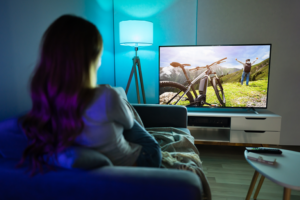
After more than 40 years of operation, DTVE is closing its doors and our website will no longer be updated daily. Thank you for all of your support.
Ofcom’s ‘nightlight’ DTT looks like a fair bet for the future of TV
Ofcom’s report on ‘Future of TV Distribution’ in the UK sets out options for a DTT switch-off, investment in a next-gen DTT platform that is more efficient, or reduction of DTT to a core service, called a ‘nightlight’. With consumer behaviour looking like the biggest challenge to a full streaming migration, nightlight seems a fair bet, writes John Moulding.
 The long-term future for broadcasting was placed firmly into the spotlight this month when the UK regulator Ofcom published its landmark report, ‘Future of TV distribution’ to kick-start a coordinated migration to what will become the next chapter in free-to-air television for the country. It outlines three possibilities, all of which assume vast amounts of streaming TV over broadband but only one of which leads directly to a full shut-down of the digital terrestrial network.
The long-term future for broadcasting was placed firmly into the spotlight this month when the UK regulator Ofcom published its landmark report, ‘Future of TV distribution’ to kick-start a coordinated migration to what will become the next chapter in free-to-air television for the country. It outlines three possibilities, all of which assume vast amounts of streaming TV over broadband but only one of which leads directly to a full shut-down of the digital terrestrial network.
Besides broadcast switch-off, there is the option for a reduced ‘nightlight’ DTT service which would provide a minimum offer, like only the main public service channels. The third option is to invest in the continuation of a full DTT platform that is more efficient and therefore cheaper to operate for broadcasters.
The continuation of DTT is being considered to ensure universal access to TV for viewers who may not be ready, willing or able to make a switch to streaming – mirroring the policy goals that preceded the analogue-to-digital migration. The role of satellite is also considered, but receives less attention given its minority contribution to free-to-air viewing in the UK.
In a ‘Summary of Stakeholder Responses’ there is even a passage noting agreement among respondents [to the report consultation] that DTT-only viewers are more likely to have vulnerable characteristics, and that some may never transition to IP. “Consumer groups and individuals flagged the importance of ensuring that this group of viewers can still access content.”
The stakeholder summary continues: “Most respondents said that some viewers have already transitioned to IP but there were different views on the number of viewers who will continue to use DTT in some way. Most broadcasters and ISPs suggested that this number will significantly decrease whereas some set manufacturers and other respondents suggested that there will not be a significant change from current figures.”
This passage points to a continuing role for DTT because this report gives the impression that human behaviour, rather than technology, is the biggest barrier to an all-streaming world. The report makes clear, for example, that high-speed broadband will reach 99% of households and so match DTT coverage. There is a broadband affordability issue for non-broadband customers if they are forced to rely on streamed TV, but presumably smart government intervention could take care of that. There are still questions about peak broadband capacity for the biggest events – but enough confidence in the technology that all-streaming is one of the options on the table.
Behaviour is not necessarily about ability or means. Drawing on the Ofcom ‘Adults’ Media Literacy Tracker’ surveys 2023, the report says the main reasons consumers cite for not taking up fast broadband connectivity is a lack of interest in going online (accounting for 69%). The next most important reasons are affordability (20%) and concerns about complexity (20%).

Source: Adobe stock
Safety net service
The most obvious weakness of the nightlight DTT option is its second-class status. The rest of the world moves ahead with more viewing options, and probably better viewing experiences on streaming. It is a safety net service – with the Ofcom report saying the core DTT service “could be a temporary transition to a fuller switch-off or remain indefinitely as a provider of last resort”.
DTT was born with the intention of ensuring that free-to-air homes remained first class citizens after the analogue-to-digital switchover, so in this important respect, use of a ‘nightlight’ model would mark a new approach. But is equality a viable policy goal alongside universality? There are three important differences from the late 1990s that suggest the answer should probably be ‘no’.
First, when switching from analogue to digital, most free TV viewers had nowhere else to go apart from government-supported spectrum and platforms if they wanted to continue seeing quality free television in a multichannel world. The only alternative was pay TV. Today, a large majority of consumers seeking free quality TV do have an alternative – streaming. Those who do not are a minority and must be protected, but their smaller numbers make DTT economics harder – and it will be especially tough for commercial broadcasters if the demographics on DTT skew older and older.
Second, during digital switchover, broadcasters had nowhere else to go, unless they were willing to satisfy themselves with Pay TV carriage and the loss of independence that would have entailed. This time they do, and channels who cannot make the numbers work for DTT carriage can shift to an all-streaming model. Without radical market interventions, there is nothing a regulator can do to prevent a DTT long-tail from becoming a short one.
Third, the last transition saw one very small ‘platform’ – analogue TV – complemented by and then ultimately replaced with another: multichannel digital TV. Even the largest broadcasters had to maintain only one or two analogue channels as their parallel ‘legacy silo’. Today, equality would require that broadcasters maintain a handful of channels, possibly in different resolutions.
The report states that multiple broadcasters and channels said it is “unlikely to be commercially sustainable or justifiable value for money for them to continue indefinitely to pay to be on as many distribution platforms as they do today.” The BBC gave evidence that cost per DTT viewer hour in 2030 will be around four times higher than it is expected to be in the financial year 2023/24 (even without inflation).
Maintaining a large-scale DTT platform (equivalent to today) beyond the 2030s is a big ask. So, what could serve as a nightlight option? Freely in the UK could surely satisfy the requirement, as a successor to Freeview. If European regulators took a similar view to Ofcom, I can see how EPG-centric FTA offers using DVB-I could do the same for other European markets. By hosting broadcast and streaming channels in the same programme guide, both these approaches provide a relatively simple UX featuring core DTT services and also help to persuade and educate consumers to take up streaming. The Freely user experience is no more complex than your average broadcast-broadband platform because, like DVB-I, a key principle is that streaming breaks out of the app.
A Freely-style nightlight in the UK would mean there is still a roadmap to more streaming on the DTT platform. Because a channel number can link to either streamed or broadcast versions of the same content, very late streaming adopters could take baby-steps into streaming versions of channels that drop off the DTT spectrum either at the outset or over time. This model counters the second-class citizen narrative, because the nightlight is more technical than presentational. There could be a handful of digital terrestrial channels for users who continue to lack or ignore broadband and streaming. But more of the 2030s/2040s television universe is available to very late-adopters who decide to finally give it a try.
If I was told I had to make the final decision on the UK’s ‘Future of TV distribution’ roadmap today, it would be:
- Full DTT (today)
- A massive drive to get Freely into homes (tomorrow)
- A bright nightlight DTT (with dozens of over-the-air channels, and streaming options available) converging on Freely, with Freeview and Freesat becoming legacy platforms which are then phased out.
- Dimming of the nightlight DTT (in the sense that some broadcast channels choose to go all-streaming, so the pure-DTT offer is reduced while the same channels are offered on the platform as streaming linear TV instead).
- Extensive on-platform and off-platform marketing to encourage viewers of lost DTT channels to watch the streamed versions (would they even notice the difference in a Freely/DVB-I environment)?
- Eventually, when government can guarantee uninterrupted Internet distribution through disaster or war, and there is an ultra low-cost or free broadband option that at least covers TV viewing (or sufficient government subsidies to low-income broadband households), and when the number of users impacted has become tiny, we turn off DTT.


